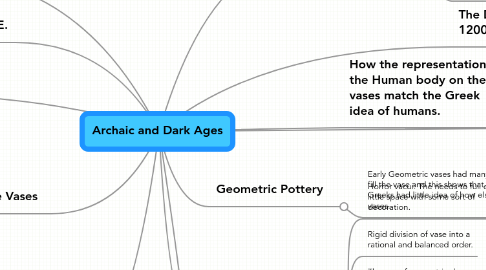
1. Background
1.1. The Greeks settled down and their society became stable. Architecture and much more of art resumed.
1.2. The Pheonicions were the ones who started the activity.
1.3. The development of the Greek alphabet.
2. Archaic Age 400-476 B.C.E.
3. The Greeks produced large amounts of ceramics during the Archaic Age.
3.1. The Greeks produced large amounts of ceramics to trade and carry.
3.2. The city that dominated the production of ceramics was Cornith.
4. Black-Figure Vases
4.1. It was used to tell stories on vases.
4.2. The figures were carved in instead of being painted on.
4.3. Exekias' Amphoras
4.3.1. 540-530 B.C.E.
4.3.2. The pottery reflects the scene and the theater.
4.3.3. He painted Ajax and Achilles.
4.3.4. Exekias focused our attention by having many images pointed in the direction of the box.
4.4. Major drawbacks
4.4.1. Difficult to scratch in details.
4.4.2. Difficult to scratch curved lines.
4.4.3. Detail are weak.
5. Red-Figure Vases
5.1. The red figure technique is similar to the black figure only that the red figures are painted on.
5.2. Advantages of Red figure: Easier to paint very fine detail, Lines can overlap, Easy to paint in expression, and Artist can control texture by controlling the line.
6. Andokides Bilingual Amphora
6.1. A vase with a black and red figure.
6.2. Achilles and Ajax are playing a game of dice with their armor.
7. The Greeks came from groups of nomadic people.
7.1. The first Greeks to arrive were probably the Aeolians, they were very peaceful and settled in northern Greece.
7.2. The second wave of Greeks were the Ionians, the first philosophers came from the Ionians and were very intelligent, wealthy, and had better art.
7.3. The third wave of Greeks were the Dorians which arrived around 1200 B.C.E. and were the most warlike of all the Greeks.
7.3.1. The Dorians conquered most of their area and wiped out the other groups of Greeks.
7.3.1.1. New node
8. The Dark Ages 1200-800 B.C.E.
8.1. The Dark Ages occured because the Dorians had no time to focus on art because they were to busy fighting.
9. The Art of the Dark Ages
9.1. The three arts the Dorians had were architecture, frescoes, ceramics and sculptures.
9.1.1. Dorians didn't have much Architecture or Frescoes but did have sculptures to signify victories over the centaurs.
9.1.2. Six pots that were mainly known as ceramics were the Hydria, Lekythos, Krater, Amphora, Kylix, Oenochoe.
9.1.2.1. The Hydria was used to pour water or other liquids.
9.1.2.2. The Lekythos was used to pour oil.
9.1.2.3. The Krater was used to mix water and wine.
9.1.2.4. The Amphora was used to store both liquids and dry goods.
9.1.2.5. The Kylix was a drinking cup.
9.1.2.6. The Oenochoe was a pouring jug.
10. Geometric Pottery
10.1. Early Geometric vases had many shapes to fill the vase and this shows that the Greeks had little idea of how else to fill the vases.
10.1.1. Late Geometric vases started in 750 B.C.E., were very big, alot more detailed, and were used as grave markers.
10.1.1.1. The vases also told many stories.
